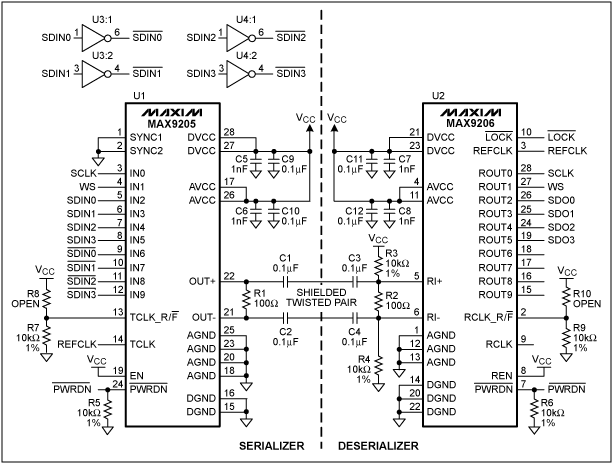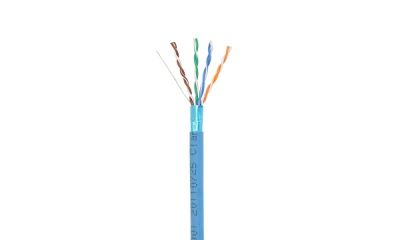This circuit is a simple and economical interface for remote IC thermal sensors. The temperature sensor (MAX6576), an absolute temperature-to-period converter that integrates the sensor with the necessary signal electronics, connects to the receiver (a MAX9140 comparator) using a twisted-pair cable that carries power to and signals from the sensor.
A similar version of this article appeared in the November 5, 2007 issue of ED magazine.
The best choice for midrange, low-to-medium-accuracy temperature measurements (considering size, cost, performance, and ease of use) is an IC temperature sensor—assuming the circuits to be interfaced with the sensor reside on the same board or in the same box. Most IC temperature sensors are designed for applications in which the circuits to which they connect are nearby, so the inclusion of sensing, digitizing, and signal-processing functions in a single IC greatly simplifies the design of such sensors and the data-acquisition interface.
Some applications, however, require the acquisition of temperature data from locations quite remote from the power supply and data-processing electronics. You must exercise extra care with such systems, because any deterioration in the signal from the remote sensor can degrade the measurement quality.
Choosing to digitize and process the signal at the point of measurement (near the sensor) greatly reduces the problem of signal integrity, but that approach also complicates the interconnection and raises the problem of supplying power to the circuit. Either design option (signal processing remote or at the sensor) requires cabling that is complex or expensive or both.
The circuit of Figure 1 provides a simple and economical interface for remote IC thermal sensors. The temperature sensor (MAX6576) is an absolute temperature-to-period converter that integrates the sensor with the necessary signal electronics. It connects to the receiver (a simple comparator) using a twisted-pair cable that simultaneously carries power to the sensor and signals from the sensor.

Figure 1. These two ICs enable the remote acquisition of temperature data over a twisted-pair cable.
Figures 2, 3, and 4 show the circuit waveforms using a short cable connection of 60cm (about two feet) between sensor and receiver. Figures 5 and 6 show the receiver's input and output pulses using a twisted-pair cable connection of 1000m (about 3300 feet). Measurements of the receiver's pulse-to-pulse output jitter (where total measurement error is the ratio of jitter to the signal period) indicates that the jitter influence is negligible, even with the long cable.

Figure 2. Receiver output pulse using a short 2-foot cable, 20µs/cm.

Figure 3. Receiver output pulse using a short 2-fooot cable, 400µs/cm.

Figure 4. Receiver input pulse for a short 2-foot cable.

Figure 5. Receiver input pulse for a long 3000-foot cable.

Figure 6. Receiver output pulse for a long 3000-foot cable.
With its TS0 and TS1 terminals connected as shown in Figure 1, the MAX6576 exhibits a digitizing conversion constant of 10µs/K. As seen in Figure 3, the output pulse period at room temperature (300K) is 3ms, which corresponds to a repetition rate of about 333Hz.
At the receiving end, you can recover the temperature data from the comparator-output pulses with a simple timer/counter routine executed by a microcontroller, or in analog form using a constant-slope, linear sawtooth generator synchronized with the received pulses, and followed by a peak sample/hold (S/H) converter. This transmission scheme can also be used with temperature-to-frequency converters and other sensors.
A similar version of this article appeared in the November 5, 2007 issue of ED magazine.
The best choice for midrange, low-to-medium-accuracy temperature measurements (considering size, cost, performance, and ease of use) is an IC temperature sensor—assuming the circuits to be interfaced with the sensor reside on the same board or in the same box. Most IC temperature sensors are designed for applications in which the circuits to which they connect are nearby, so the inclusion of sensing, digitizing, and signal-processing functions in a single IC greatly simplifies the design of such sensors and the data-acquisition interface.
Some applications, however, require the acquisition of temperature data from locations quite remote from the power supply and data-processing electronics. You must exercise extra care with such systems, because any deterioration in the signal from the remote sensor can degrade the measurement quality.
Choosing to digitize and process the signal at the point of measurement (near the sensor) greatly reduces the problem of signal integrity, but that approach also complicates the interconnection and raises the problem of supplying power to the circuit. Either design option (signal processing remote or at the sensor) requires cabling that is complex or expensive or both.
The circuit of Figure 1 provides a simple and economical interface for remote IC thermal sensors. The temperature sensor (MAX6576) is an absolute temperature-to-period converter that integrates the sensor with the necessary signal electronics. It connects to the receiver (a simple comparator) using a twisted-pair cable that simultaneously carries power to the sensor and signals from the sensor.

Figure 1. These two ICs enable the remote acquisition of temperature data over a twisted-pair cable.
Figures 2, 3, and 4 show the circuit waveforms using a short cable connection of 60cm (about two feet) between sensor and receiver. Figures 5 and 6 show the receiver's input and output pulses using a twisted-pair cable connection of 1000m (about 3300 feet). Measurements of the receiver's pulse-to-pulse output jitter (where total measurement error is the ratio of jitter to the signal period) indicates that the jitter influence is negligible, even with the long cable.

Figure 2. Receiver output pulse using a short 2-foot cable, 20µs/cm.

Figure 3. Receiver output pulse using a short 2-fooot cable, 400µs/cm.

Figure 4. Receiver input pulse for a short 2-foot cable.

Figure 5. Receiver input pulse for a long 3000-foot cable.

Figure 6. Receiver output pulse for a long 3000-foot cable.
With its TS0 and TS1 terminals connected as shown in Figure 1, the MAX6576 exhibits a digitizing conversion constant of 10µs/K. As seen in Figure 3, the output pulse period at room temperature (300K) is 3ms, which corresponds to a repetition rate of about 333Hz.
At the receiving end, you can recover the temperature data from the comparator-output pulses with a simple timer/counter routine executed by a microcontroller, or in analog form using a constant-slope, linear sawtooth generator synchronized with the received pulses, and followed by a peak sample/hold (S/H) converter. This transmission scheme can also be used with temperature-to-frequency converters and other sensors.
 电子发烧友App
电子发烧友App
































评论